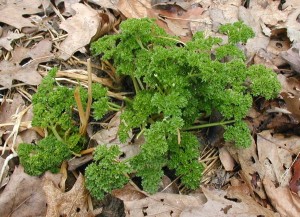Parsley is one of the herbs that we always have growing. Sometimes it’s planted in the vegetable garden and other times it’s planted with the herbs along the walkway. You’ll need growing space of at least 1 sq. ft. for one parsley plant.
Parsley is a biennial plant, one that grows for two years, flowering in the second year. It will overwinter here at Zone 6, but I’m not sure how far north you can go and still get the second year crop. Further north parsley is probably treated as an annual by planting it each year. To protect it over the winter, we pile up leaves all around the parsley plants and perennial herbs.
The first year is pure vegetative growth. The plant will get larger and bushier. When the stems are too long they won’t remain erect and droop out to the sides, making the parsley plant into a large round shape.

Second year growth is primarily involved with sending up a flower stalk. Biennials require some sort of winter period of dormancy before they can flower. During the second year you should harvest as early in the year as possible because the plant will put most of its energy into creating the flower stalk, flowers and seeds, not in producing more parsley leaves.
Bolting is the term given to the rapid growth of the flower stalk in the second year. Once the plant has bolted, you might as well find another parsley to transplant. After bolting and setting seed the parsley plant dies.
Harvest any of the parsley as it grows. You can use scissors or just your fingers. The stems are pliable enough to let you just pinch off a piece. Snip off a sprig here and there for garnishes.
Before the flower stalk gets too tall, we usually harvest most of the parsley and put it in freezer bags, as is. Once frozen, you can use scissors to snip off some parsley for your soup or potatoes when ever you need it, and re-freeze the remaining parsley.
![Reblog this post [with Zemanta]](http://img.zemanta.com/reblog_e.png?x-id=9f08bc26-d63b-48b9-a7d3-ae94dc15c1ae)